The mustard family includes vegetable crops like broccoli and cabbage, and several weed species commonly found in Kansas Mustard species can often be difficult to differentiate, especially when in the cotyledon or rosette stage. It is important to be able to identify these weeds as some of them vary in their sensitivity to common herbicides. These weeds can often be troublesome in winter crops, like winter wheat. Mustards germinate in the late summer and early fall, overwinter as a low-growing rosette, and flower, or bolt, in the spring. Flowers of mustard species all have 4 petals and are replaced by seed pods called siliques. Key features for identification are summarized in Table 1.
Ecology and identification of mustard species
Blue mustard (Chorispora tenella) is native to Asia and the middle east but was introduced to the U.S. from Siberia. Blue mustard seedlings have oval to oblong cotyledons, the first true leaves are alternate, and the leaves tend to have a rough surface. All green parts of the plant have white hairs and the plant emits a unique, unpleasant odor. Leaves in the rosette tend to be pinnately lobed or have large round teeth (Figure 1, left), while the leaves attached to the stem are slightly toothed or have smooth edges. Blue mustard tends to bolt sooner than other mustard species. Once bolted, blue mustard is 12 to 18” tall and will eventually bear purple or blue flowers at the top of the plant (Figure 1, right). Rectangular seeds that are flat on one side and round on the other are produced in siliques that are generally 1 to 2” long with a beak at the end. Seeds can be viable as soon as 10 days after the plant blooms.
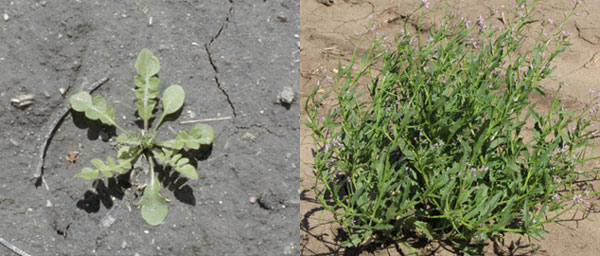
Figure 1. Blue mustard seedling (left) and mature plant (right). Photos by Dallas Peterson.
Bushy wallflower (Erysimum repandum), also known as treacle mustard, is native to Eurasia. It emerges in the fall and overwinters as a rosette. Cotyledons are small and spoon shaped, tapered at the base, and slightly notched at the tip. The rosette has long, narrow leaves that are irregularly notched (Figure 2, left). Leaves are alternate in on the stem and the stem zig-zags at nodes. Bushy wallflower grows 12 to 18 inches in height and bears bright, yellow flowers at the top of the plant that have white sepals (Figure 2, right). Oblong, orange-brown seeds are formed in narrow siliques that are 2.25 to 4.75 inches long.
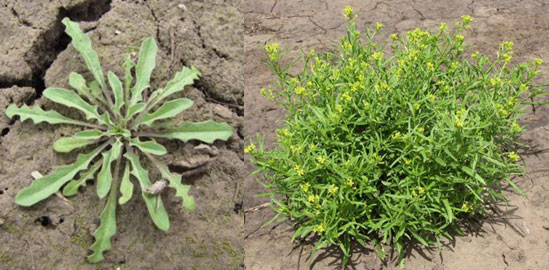
Figure 2. Bushy wallflower rosette (center) and mature plant (right). Photos Dallas Peterson.
Pinnate tansymustard (Descurainia pinnata), a native plant, and flixweed (D. Sophia), introduced from Eurasia, are very difficult to distinguish. Both emerge in the fall and overwinter as a rosette with finely-lobed, lace-like leaves, although pinnate tansymustard has reddish-green to purple stems (Figure 3, left). Mature plants of both species are covered in dense, fine hairs. After bolting, leaves of both species are alternate on the stem and become smaller higher up on the stem. Pinnate tansymustard leaves are smaller, ranging from 0.25 to 2.5 inches long, while flixweed leaves range from 1.25 to 4 inches long. Flowers of both species are usually yellow and occur in small clusters, but pinnate tansymustard flowers can range in color from yellow to yellow-green to white. Another difference is that flixweed sepals (the green structures just below the petals) are longer than the petals. One key difference in the two species is the siliques (Figure 3, right). Pinnate tansy mustard siliques are short (about 0.25 inch) and club-like silique with a prominent midrib which flixweed siliques are longer (0.5 to 1 inch) and narrower, and are attached to the stem at right angles. Both species spread by oblong seeds during the summer. Pinnate tansymustard seeds are dark red-brown and flixweed seeds are bright orange.
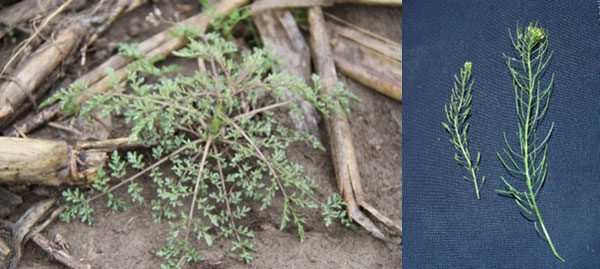
Figure 3. Pinnate tansymustard rosette (left) and flowering stems of pinnate tansymustard and flixweed(right). Photos Dallas Peterson.
Field pennycress (Thlaspi arvense) can emerge in the fall and overwinter as a seedling or a rosette, or it can emerge in the spring from seed. Cotyledons are oval to oblong and have a very long petiole, up to ¼”. First true leaves are round to oval with a prominent midvein and occur on long petioles and do not have hairs. Leaves grow into a rosette and are oval in shape with wavy edges and do not have hairs (Figure 4, left). When field pennycress bolts, the leaves are lanceolate in shape, attach directly to the stem, have slightly toothed edges, and pointed lobes (Figure 3, right). The plant ranges from 4 to 24” in height. Stems do not have hairs and only branch on the upper portions of the plant. Flowers are white and occur in clusters at the end of the stems. The seeds can be found in circular, flat seed heads that are 1/2” in diameter with a distinctive wing along the edge. Field pennycress is a prolific seed producer and can produce up to 15,000 seeds per plant and seeds can remain viable for 10+ years in the soil. Persistent seed viability and prolific seed production have allowed field pennycress to be a troublesome weed in horticulture crops and winter wheat. This weed also has a strong odor that can cause cows to have bitter-flavored milk if they consume it.
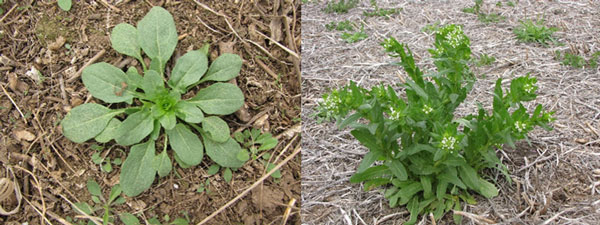
Figure 4. Field pennycress rosette (left) and mature plant (right). Photos by Dallas Peterson.
Shepherd’s-purse (Capsella bursa-pastoris) can germinate in the fall and overwinter as a rosette or it can germinate in the spring. Cotyledons are egg shaped or spatulate and have a slight notch at the tip. The hypocotyl is light green to purple. The first two to four leaves are somewhat round with smooth or toothed lead edges. The first set of leaves are opposite. When growing in a rosette, leaves are variable. Leaf edges can be smooth or be toothed to deeply lobed, which is the most common (Figure 5, left). There is a line of hairs on the midvein on the lower leaf and hairs on the upper leaf. Stems of bolted plants (Figure 5, right) are green to purple in color, range from 4 to 20 inches tall, and generally only have hairs on the lower portion. Leaves are only found on the lower part of the stem and are alternate and lanceolate and attach directly to the stem. Flowers are small and white to green and can be seen from spring to late fall. Very small (less than 0.1 inch), orangish-brown seeds are produced in a distinctive flat and triangular or heart shaped seed pod.
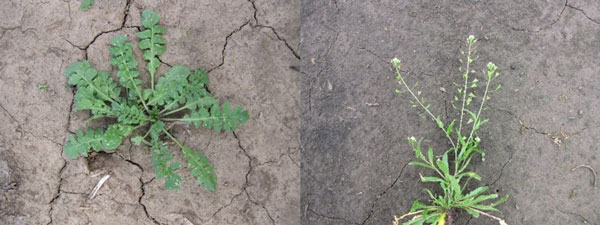
Figure 5. Shepard’s-purse rosette (left) and mature plant (right). Photos by Dallas Peterson.
Control of mustard species
There are some non-chemical control measures for managing mustard species. These include purchasing weed-free seed and maintaining field edges so mustards cannot become established or produce seeds. Light tillage can be used to stimulate germination and increase herbicide effectiveness; however, mustard seeds tend to be long-lived in the soil, so frequent deep tillage is not an effective control method.
Regardless of the herbicide, mustard species are easier to control while still in the rosette stage. In addition, early control of mustards will reduce the impact on yield. 2,4-D is effective on mustard species; however, growth stage restrictions may reduce the effectiveness in winter wheat. Dicamba and fluroxypyr, two other Group 4 herbicides, are less effective on mustard species. Huskie (pyrasulfotole + bromoxynil), which combine herbicides from group 27 and 5 also controls mustard species. The Group 2 herbicides Ally and other metsulfuron-containing products, Amber and other triasulfuron-containing products, or Glean and other chlorsulfuron-containing products can also provide excellent control of mustard species. However, both blue mustard and flixweed resistant to Group 2 herbicides have been confirmed in Kansas.
Table 1. Some identifying features of selected mustard species.
|
Species |
Emerges |
Basal leaves |
Flowers |
Fruit |
|
Blue mustard |
Fall |
Pinnately lobed |
Blue/purple |
Narrow |
|
Bushy wallflower |
Fall |
Wavy margins |
Bright yellow |
Narrow |
|
Pinnate tansy mustard |
Fall |
Finely lobed |
Pale yellow/white |
Club-like |
|
Flixweed |
Fall |
Finely lobed |
Pale yellow |
Narrow |
|
Field pennycress |
Fall, spring |
Wavy margins |
White |
Oval, flat |
|
Shephard’s-purse |
Fall, spring |
Deeply lobed |
White |
Heart-shaped, flat |
For more detailed information, see the “2021 Chemical Weed Control for Field Crops, Pastures, and Noncropland” guide available online at https://bookstore.ksre.ksu.edu/pubs/SRP1162.pdf or check with your local K-State Research and Extension office for a paper copy.
The use of trade names is for clarity to readers and does not imply endorsement of a particular product, nor does exclusion imply non-approval. Always consult the herbicide label for the most current use requirements.
Tyler Meyeres, Weed Science Graduate Student
tpmeyeres@ksu.edu
Sarah Lancaster, Extension Weed Science Specialist
slancaster@ksu.edu
Tags: mustards World of Weeds